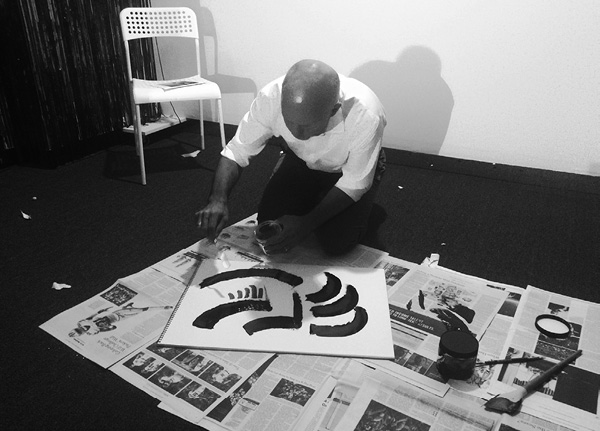
THIS MAY GUIDE US
first performed on October 18, 2016
AC Institute, New York, NY
performed once in 2016
GEOF HUTH
New York, NY
747200462g747200462e747200462o747200462f747200462h747200462u747200462t747200462h747200462@747200462g747200462m747200462a747200462i747200462l747200462.747200462c747200462o747200462m
dbqp.blogspot.com
THIS MAY GUIDE US
GEOF HUTH
All human action and interaction is extemporaneous—any performance, even if practiced hundreds of times; any written work, because even the editing of the work is itself extemporaneous. In this piece, I wanted to produce a bare outline of the sections to be performed ahead of time that I would perform without prior preparation. I usually document my performances through some kind of handout created beforehand. For this performance, I prepared one heavy, folded sheet of paper illustrated with two abstract visual poems on its covers. The handout included the six movements in the performance on the right-hand page and an original rubberstamped poem on the left. The creation of those rubberstamped poems, early in the morning, was the unseen beginning of the performance. At the beginning of the performance, I said “this may guide us” as I began to hand out the folded sheet. Listed below are descriptions of the six movements of the performance:
- We All Hate It
I begin with a spoken poem about poetry - how it fails to achieve its goals, how we allow it to waddle through pabulum without eliciting surprise (its purpose).
- Say a Word
I ask the audience to say a word, and from this I create a spoken-word poem. The audience is hesitant to say a word, and my poems in response are short.
- Sketch a Thought
I slowly unfold a newspaper on the floor. I open a large pad of drawing paper and lay it down. I begin to paint in red and black, talking about the process of making this visual poem.
- Spool a Symbol
I ask the audience to spool a symbol. I demonstrate that this means to talk in gestures, rather than with words. The audience cannot figure out how to do this, so I show them. This is the least successful section of the performance.
- Sound a Thought
I speak in tongues, giving a dramatic poem with no content except sounds.
- Sing a Meaning
I sing a song with nonsense syllables. When the song is finished, I clean up the stage. The audience does not know how to react. Eventually, they applaud.
The goal of the work was to produce a range of totally extemporaneous poetic expression during a performance, creating successful poetry as a result. As I was not entirely fulfilled with the result, this performance teaches me the importance and merit of practicing these forms of extemporaneity before attempting them again. From experience, the previously rehearsed activities go better than those I have not prepared beforehand.